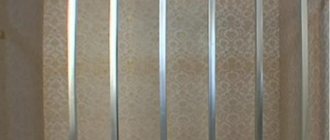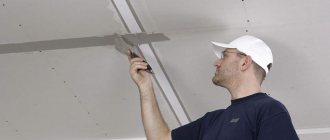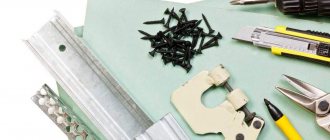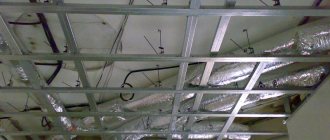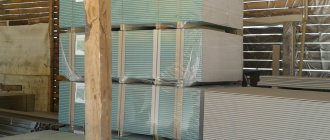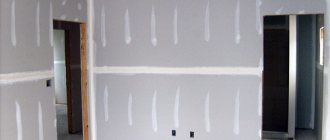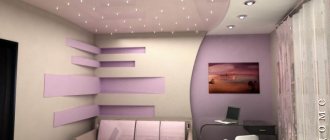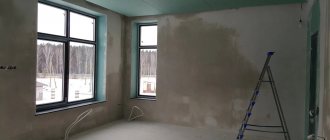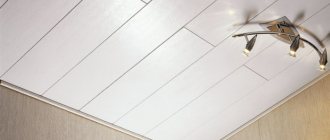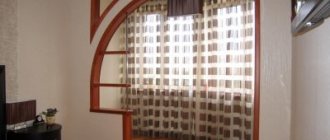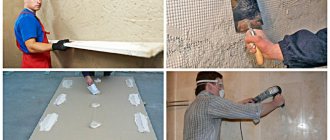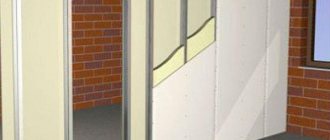Installing drywall on walls and ceilings is a fairly simple job that you can do yourself. Installation of plasterboard is carried out on the ceiling or walls on the wall using a profile. Drywall is a material that will allow you, quite independently, quickly and easily, with minimal investment of time and money, to level and prepare walls for further finishing in any room of a wooden, brick or panel house. We will tell you in our article how to install drywall on walls and ceilings correctly so that they are not only smooth, but also durable.
Drywall: scope
Drywall has long gained popularity as a flexible and versatile material for construction and repair. Installing drywall is not as complicated as it may seem at first glance. It is enough to understand some rules and nuances.
Drywall is a sheet made from gypsum. It can be in size 1.2*3 m or 2.5*1.2. The material is covered on both sides with thick cardboard. Because of this composition, it is considered environmentally friendly. But during manufacturing, additives can be used to impart certain qualities to the building material: moisture resistance, heat resistance.
When performing repair work, plasterboard can be used for the following purposes:
- Insulation of premises.
- Construction of partitions, walls, niches, various complex structures.
- Leveling surfaces. It is worth noting that this is a fairly economical and fast method.
To the ceiling on the frame
Unlike wall plasterboard, ceiling plasterboard is thinner, its thickness is 8.5 cm. This is due to relatively lower impact loads and the need to lighten the structure. Wall sheets can be used, but only if there is no other option, since in this case the sheathing will have to be strengthened.
Sequencing:
- Marking. A laser or water level on the walls marks the perimeter of the ceiling.
Either its lowest point or the value determined by the project is taken as the basis. Also at this stage it is better to note the location of the frame profile and the fastening of the brackets. The guides are installed on two opposite walls. The frame profile should be located at the edges of each sheet and two strips in the middle (when installed lengthwise). The jumpers are marked perpendicularly, every 50 cm, taking into account the size of the sheets (so that they fall on the joint). - Installation of guides. Guides (UD-27) are attached according to the markings. Fixation to the walls is done with dowel screws.
- Installation of frame profile. The CD-60 profile is inserted into the guides and secured to them with small metal screws.
It is additionally fixed to the ceiling with strip brackets in increments of 30 cm. - Jumpers. They are made from CD-60 (sawed at the joints with a grinder or scissors), attached to the main profile with small metal screws (flea).
If you plan to hang a chandelier for it, you need to prepare a place in advance. You can install a mortgage from a wooden block, but it is better to make everything from metal, especially since there are ready-made solutions for such situations on sale.
Drywall installation - what you need to know
Installation of drywall is carried out in several ways:
- Apply strong special glue to leveled surfaces. Next, you will need a finishing finish, for example, dry plaster. It is not recommended to use it to make wood surfaces even.
- On a pre-prepared frame. With a similar installation, it can also be used for wooden floors. The frame can be made of either metal or wood.
Wooden bases are cheaper, since only blocks of wood are required for execution. Metal ones are made from galvanized profiles, special hangers, and connecting elements. This is a more reliable and durable option.
Before starting installation, you should familiarize yourself with several rules:
- The joints of the sheets are placed strictly on the frame and fixed with self-tapping screws.
- The seams must be taped with joining tape.
- External corners are closed with special corners.
- Interior partitions are mounted in two parallel layers.
Frame installation of gypsum boards
The use of a frame in plasterboard structures is the most common cladding method for any type of material use.
List of required tools :
- hammer drill or drill with impact function;
- grinder or metal scissors for cutting profiles;
- level, tape measure, pencil;
- screwdriver with a set of bits;
- riveter, if the frame is assembled on such hardware;
- spatulas;
- sandpaper and sickle tape;
- container for mixing the solution.
The frame is made from mounting profiles : ceiling, rack, guides. Additionally, you will need single-level connectors - “crabs” and hangers.
For work, purchase different types of self-tapping screws :
- Galvanized without a drill at the end for connecting metal frame parts, size 19x3 mm. To pre-drill holes for this fastener, you will need a drill 0.3 mm smaller than the diameter of the screw.
- Galvanized with a drill tip 3x12 mm.
- Oxidized (black) with fine pitch if the frame is made of galvanized profile or with large pitch for wooden bases. The length of the threaded rod should be 2 times the thickness of the drywall - this is convenient when working and allows you to hold the fasteners with your hands.
Depending on the installation location, one of the types of drywall :
- GCR is a standard material for structures used under normal conditions with normal air humidity;
- GKLV - moisture-resistant option for bathrooms;
- GKLO - fire-resistant, withstands elevated temperatures: used for fire partitions or for the walls of electric fireplaces.
Installation of drywall on walls - technology
It can be noted that the sequence of installation of gypsum boards on surfaces made of various materials is approximately the same:
- the frame must be leveled;
- the guides are attached specifically to the wall surface with the same pitch;
- racks are used as load-bearing components;
- the frame can be supplemented with guide profiles to increase reliability;
- frame elements are placed at a distance of 0.4-0.6 m;
- A gap of 1-1.5 cm should be left from the floor and ceiling.
Video: installing drywall on walls
There are a number of differences in fastening drywall, taking into account the material of the walls:
- The sheets are attached to the concrete wall using a hammer drill and 60 mm dowel nails.
- The correct installation of drywall to a brick wall is carried out in the same way, but the quality and strength of the masonry should be taken into account. For old buildings and those made of hollow bricks, dowel-nails with a length of more than 80 mm are used.
- The frame is mounted on foam blocks using pancake screws without preparing holes.
- If the wall is made of wood, then fastening occurs with nails or self-tapping screws. A frame must be built on curtains with a stroke of up to 6 cm.
Additional materials for installation
How to attach a profile for drywall? In this case, you cannot do without auxiliary elements. Scroll:
- a coupling connecting the PP, if the length of one strip (maximum 4 m) is not enough;
- a cross-shaped crab that strengthens the structure at the intersection of the slats;
- a straight hanger that is attached to the surface of a wall or ceiling and bent along the lines on it. A profile is inserted and fixed into the resulting opening. The excess is cut off or damaged. Direct suspension allows you to level the walls with plasterboard with the frame yourself;
- anchor suspension that allows you to adjust the height of the inter-ceiling space;
- hardware used to fix the structure.
Having such a set, you can easily cope with creating the correct frame for drywall on the wall.
DIY drywall installation: 14 rules for successful installation
Experts identify a number of rules that will help to carry out repair work correctly:
- Accurately determine the position. Be sure to mark with chalk, cord or pigment. How the installation itself will proceed depends on this.
- Install profiles correctly. They must be insulated from the floor with some kind of elastic material. This will provide sound insulation. Foam, felt, rubber, cork are suitable.
- When measuring the length of the posts, subtract the thickness of the soundproofing material. Additionally, a gap of 1.5-2 cm is made.
- When installing wall partitions, the openings should be strengthened. A rigid profile is suitable for this.
- The slabs must be carefully trimmed. A line is drawn on the outside of the sheet - where there is no print, and there are chamfers at the ends for connection.
- Sheets should be attached carefully. Phosphated screws are used for this. They are not prone to corrosion due to contact with gypsum. The cap is hidden in a sheet of 0.5 mm, and then filled with putty. There should not be too much putty between the sheets, as this will lead to cracks.
- Avoid using additional elements. You should immediately take as a basis sheets whose size is slightly larger or corresponds to the required one.
- The need for insulation and sound insulation should be considered in advance.
- When installing plasterboard walls, the layout on the second side must be offset so that the seams do not coincide.
- The seams must be puttied. In this case, the mixture must be pressed as deeply as possible and smoothed out on top.
- It is necessary to select the correct reinforcing tapes taking into account their purpose.
- To avoid deformation, do not make joining seams in the middle of doorways.
- To cut niches and openings, you need to use gypsum board crowns.
- It is recommended to start attaching sheets from the center or corner.
Advantages and disadvantages of plasterboard wall structures
To begin with, it probably makes sense to briefly highlight the positive and negative aspects of a wall frame structure made of plasterboard. Having understood them, it will be possible to competently decide whether such a partition is suitable for a particular case or not.
After finishing work, the plasterboard structure will look like a full wall.
So, the advantages of plasterboard partition structures include the following points:
- The materials used for the construction of such walls are quite light, so they will not weigh down the interfloor floors. Consequently, the mounted structure will be absolutely safe for the building.
- Walls and partitions made of plasterboard are not permanent, so their construction does not require obtaining a permit, the obtaining of which involves the loss of a considerable amount of time, money, effort and nerves.
- Drywall is produced in several versions - these are simple sheets (GKL), moisture-resistant (GKLV), fire-resistant (GKLO). Lightweight sheets are produced for ceiling structures. Therefore, walls and partitions can be erected from this material in any of the rooms, including in the bathroom or near the stove or fireplace.
- The affordable cost of both the drywall itself and the components for building the frame allows a family to purchase them for repairs, even with a modest budget.
- It is quite possible to design and install plasterboard walls that have complex decorative and useful shapes, such as arched doorways or functional niches and cabinets, allowing you to avoid purchasing furniture accessories.
- When leveling walls with this material, you will not need to remove the old plaster.
- The construction of walls made of plasterboard (or when leveling walls with plasterboard using a frame method) allows for immediate insulation and sound insulation work.
- You can hide electrical wiring in the frame of the wall being built.
- There is a complete opportunity to do without the involvement of a team of builders, since all the work can be done independently or with one assistant.
- The material is “breathable” and environmentally friendly, which is important for furnishing residential premises.
- A wall or partition erected using this method turns out perfectly smooth, suitable for any facing material, be it wallpaper, paint or ceramic tiles.
Moisture-resistant plasterboard sheets are used to level or line the walls in the bathroom.
Is it possible drywall in the bathroom? Yes, sure!
With proper installation and special preparation of surfaces, gypsum board sheets will not be afraid of the specific conditions of a bathroom or combined bathroom. And perfectly smooth walls are an excellent opportunity to tile them. Instructions for such finishing are contained in a special publication on our portal “Tiles on drywall in the bathroom” .
Drywall prices
drywall
Now, for the objectivity of the picture, it is necessary to consider the negative aspects of the plasterboard structure. It is advisable to know about them in advance, so that later, when using the rooms, you do not encounter some unexpected inconveniences. :
Wooden bookmarks in a metal frame of a plasterboard structure
- A wall made of this material will not be able to withstand hanging any heavy objects directly onto the plasterboard, since the sheets are quite thin (12.5 mm), fragile, and the gypsum itself is not particularly strong. Therefore, if in the future there is a plan to hang, for example, a TV or sconce on the wall, then their location must be determined at the design planning stage, and additional jumpers made of a metal profile with wooden bookmarks must be provided for fastening.
- The wall structure will have a minimum thickness of about 80 mm, and often much more. This reduces the area of the room somewhat. But think about it, what if you use other materials for the partition? Almost any other will give even greater thickness. Therefore, this drawback can be called very doubtful.
Expert opinion: Afanasyev E.V.
Chief editor of the Stroyday.ru project. Engineer.
As you can see, these shortcomings are completely solvable problems. From which we can conclude that a plasterboard wall for an apartment is the best option if it is necessary to divide the room into separate zones or even isolated rooms.
Installation of drywall on walls and ceilings using metal profiles
Marking for the frame
The action is carried out using a painting cord. A straight line is marked on the floor, which is the boundary of the frame. Then it is duplicated on the ceiling using a plumb line, a level and a pencil cord. Strictly vertical lines are drawn on the walls for mounting rack elements. The pitch is measured so that the joints fall in the middle of the rack profiles. Typically it is 600 mm.
Installation of guides
Installation of the frame is the next step. The horizontal profile guides on the side that will be adjacent to the base are covered with a special sealant. Its role is played by the tape. It is this that provides sound insulation. After this, drill holes for the dowels. A profile with insulation is attached to them.
The guides must securely hold the drywall, so between the screws you need to choose a step in the range of 50-100 cm. Each segment is attached in at least three places.
Types of profiles
- CD - ceiling profile 60x27 (PP). It bears the main load and holds the weight of the finished structure. This profile has side partitions of increased rigidity. It is used for finishing walls and ceilings.
- Guide profile 27x28. This auxiliary profile is designed for fastening structural sheets. It sets the planes of future products. It is used both to connect the frame to surfaces and to connect different planes of the structure.
- UW - guide profile 50x40, 75x40, 100x40 (PN) is used to create partitions. The PN is mounted to the ceiling and floor adjacent to the wall.
- CW - rack profile 50x50, 75x50, 100x50 (PS), strengthens the frame of the partitions. It is installed vertically. GCRs are attached to it on both sides.
- Arched profile. These are special curved profiles of convex and concave shapes. This type of profile is used to create complex structures of smooth shapes, with all kinds of bends.
Metal profiles are mounted using additional fasteners:
- A two-level CD profile connector fastens perpendicular profiles of different levels. To install this part, it is given the shape of the letter “P”.
- A single-level connector, also called a “crab”, is used to connect crossbars of the same level using the criss-cross method. When installed in the profile, it snaps into place and is then secured with self-tapping screws. One connection may require 8 screws.
- Straight CD hangers are metal plates. When fastening, they are also given a “U” shape. They are used for suspended ceilings. The middle section of the plate is attached to the surface, and the profile is fixed using the curved edges.
- The anchor suspension is also designed for attaching the CD profile to the ceiling. It is used when the direct suspension is not long enough. A suspension of this type is inserted into the profile, and its rod is threaded through special holes in the spring. The rod can withstand up to 25 kg load.
- Extension for CD profile (longitudinal connector) is used to lengthen the supporting profile. It is connected to the profile with self-tapping screws.
- The corner connector is also used as a crab when creating a frame for suspended ceilings of the same level.
- The structure is attached to permanent surfaces, for example, ceilings and walls, with dowels, and using self-tapping screws of various types, plasterboard is fastened to metal slats.
How to glue drywall
The sheets are attached to flat surfaces using specialized glue. This is the easiest and fastest installation method. But it is only suitable for leveled surfaces. A difference of no more than 20 mm is allowed. This takes up less room space. There are two ways to fasten sheets:
- On clean and primed walls.
- On strips of Perlfix glue 10 cm wide.
Drywall should be fixed only after the wires have been laid and sound insulation has been thought out. Glue is applied around the perimeter and in the middle of the sheet. To ensure uniform application, use a notched trowel. After the glue has hardened, you can strengthen the structure with dowel nails.
You can also attach drywall to polyurethane foam. In this case, the sheets are attached to long screws, and the gaps are filled with foam.
How to build a frame in the corner of a room
Installing drywall on a wall with a frame is not difficult and anyone can handle it. But it also has difficult moments, such as setting the corner of the room. They come in two types: external and internal. Work on each is carried out differently.
How to build a drywall frame for an internal corner
If the installation of the frame for drywall on one wall has already been completed, you need to proceed to the next one. This is where the difficulty in work arises. Since it is not possible to install the end stand on the wall, you will have to use the already installed PS profile as a base.
The racks are fastened using self-tapping screws that are nine and a half centimeters long. The stand needs to be secured every thirty centimeters. The racks are connected as follows:
- the stand serving as the base is attached to the adjacent side;
- the outermost profile, which serves as the beginning for the construction of the adjacent wall, is attached to the base with the front side.
How to make a frame for an external corner
Constructing an external corner is much easier, since in this case it is enough to place racks on each side of the corner and attach them to the wall and supporting profiles.
For the corner of the frame, you will need to install two posts, attaching one of them with the front side to the side of the other Source www.remontnik.ru
Tools, materials and components for installation
To attach drywall, you may need the following tools and materials:
- For marking surfaces and sheets: level, plumb line, simple pencil, tape measure, painting cord.
- For installation: knife, special scissors for metal, screwdriver, hammer drill, hammer.
- Accessories: guide profiles, racks, hangers, dowels, screws, glue, foam.
The set of tools may vary depending on the situation, the material of the walls or ceilings, and the purpose of using drywall.
Installation secrets: how to cut drywall
It is necessary to cut plasterboard sheets with a special knife. To ensure an even cutting line, it is better to use a long strip. The paper is cut along it and pressed onto one part of the sheet. After these steps, the plaster will break and you will have to cut the remaining paper with a knife.
If you need to cut a large number of sheets, you can use a special cutter. The edges of the sheets are made at an angle in order to increase the area of the seams. They will subsequently be puttied. Therefore, you should leave 5 mm from the edge and cut off excess material along the bias.
Insulation for drywall
There are often cases when premises require insulation. This can be encountered especially often when carrying out repair work on balconies and loggias. The proven insulation is usually glass wool or mineral wool. They are laid after the sheathing has been built and covered with sheets of plasterboard.
What are the differences between different types of drywall
There are several types of classifications of finishing materials. According to the scope of use, it is divided into the following types:
- For rooms with normal or low humidity, a standard version with a gray front side and blue markings is designed. Suitable for making partitions, leveling walls in a living room, bedroom or nursery. Designation – “GKL”.
- In the kitchen, bathroom, restroom and other damp rooms, a moisture-resistant sheet with hydrophobic impregnation and additives that prevent the appearance of fungus is used. The appearance is distinguished by a greenish tint. It bears the stamp “GKLV”.
- In places of increased fire danger, “GKLO” is used - fire-resistant plasterboard with reinforcing components made of fiberglass and clay. Can withstand open fire for up to 1 hour. It has a characteristic pink color, red numbers and letters.
- The combined “GKLVO” combined the qualities of the two previous varieties.
- "GKLF" can be attached to the external facade of the building. It is characterized by increased resistance to weather conditions and a high price.
Depending on the thickness of the plasterboard sheet, it can be:
- Wall for installation of slopes and partitions, wall finishing, etc. It has the following dimensions: width 120 cm, length 200 (250, 300) cm, thickness 1.25 cm.
- Lightweight ceiling. Its dimensions are 120x200x0.9 cm and 120x250x0.9 cm.
- The most plastic arched one for creating domes, convex and wavy structures. A standard sheet 120x250x0.65 weighs 16.4 kg, which facilitates the work of the master and allows the sheet to be attached to various surfaces with a radius of 30 to 100 cm.
Plasterboard sheet can have different widths.
According to the type of edge of the main body there are:
- “PLUCK” – with a semicircular thinned one, the most common. Development of the German manufacturer Knauf. Characterized by the highest quality seam sealing.
- “PC” – with a straight (end) one, which is rarely on sale.
- “UK” - with a thinner, often found on sheets of the Gyproc company. To finish the joints it is necessary to use reinforcing tape.
Finishing work with drywall
After completing the above work, you need to start finishing. Before painting, the sheets are covered with putty and leveled. Afterwards, all surfaces must be primed if painting is required. It is recommended to paint with water-based paint. It is also possible to use a primer. To do this, dilute the paint with water in a ratio of 3:1.
It is possible to finish drywall with the following materials: wallpaper, decorative plaster. Surface preparation is carried out in accordance with the manufacturer's instructions.
Installation cost
Prices for services may vary in different regions. They also depend on the complexity of the work performed. The approximate cost for different types of work is as follows:
- Wall cladding in one layer - from 350 rubles per square meter.
- The construction of partitions in two layers starts from 500 rubles, and in one layer from 400.
- Ceilings on metal lathing – from 550.
In addition, additional services may be offered:
- Sound insulation - from 80 rubles per square.
- Painting work for preparation for wallpapering - from 420 rubles.
- Painting work for painting - from 550 rubles.
Lathing made of wood or profile, which is better?
There are not many materials available that are suitable for a frame under plasterboard: metal and wood. It is worth understanding the features of each of them:
- Metal sheathing, unlike wood, has moisture-resistant properties. She is also not afraid of temperature changes. But wood, in turn, can become deformed under the influence of cold or heat.
- Fungus, bugs, and mold develop their lives only on wooden beams.
- Metal doesn't burn. Moreover, it does not support fire. For rooms with a high probability of fires, it is better to choose a galvanized profile.
- Wooden beams must be pre-treated with antiseptics and fire retardants. This makes repair work more expensive, and you have to spend a lot of time processing and drying the wood.
- The width and length of the metal profile are the same, it does not require rejection due to non-compliance with the dimensions.
- Wooden beams are several times cheaper than metal.
- The tree is firmly fixed with self-tapping screws. While in metal the self-tapping screw is held on only by one turn.
More often, a metal profile is chosen, since it is easier and more reliable to use.
Making lathing from wooden beams
The work includes several stages:
- Wood preparation. It is better to use coniferous trees. Before installation, the wood must lie in the room where the renovation will be carried out for several days. You should make sure in advance that the raw materials have undergone appropriate treatment with fire retardants and antiseptics.
- Trace. This is marking the lines along which the frame will adjoin the walls, floor and ceiling. It is easier to mark a point on the ceiling and transfer it to the floor near the wall using a plumb line. To do this, a nail is driven into a point and a weight is suspended from the thread. The resulting points are connected by a line along the wall.
After this, a perpendicular to the wall from the bottom point is required. This will be the second line of the partition. From its extreme point a third line is built along the wall. On the ceiling, you then need to connect the existing points and you will get the fourth. This is how the boundaries of the partition become visible
- Frame installation. The frame is built from vertical and horizontal beams. And they start making it only from the frame. First of all, the bars are secured along the constructed lines using self-tapping screws or dowel-nails. It should be taken into account that the beam on the floor should not be solid, but located on both sides
- Doorway. First you need to install two racks along the edges. The width of the opening is usually 3-5 cm wider than the door frame. They are reinforced with additional horizontal bars. Additional rigidity will be provided by vertical bars along the opening.
- Racks. They are placed in increments of 0.6 m. It is recommended to use metal corners for connections. It is better to install the racks so that the wall contains the maximum number of whole sheets of gypsum board.
Installation of a metal profile lathing frame
The creation of a metal sheathing can be divided into 3 stages:
- You should start by developing a sketch or design diagram. At this stage, it is imperative to take into account that the distance between the guides should be in the range of 40-60 cm, and hangers should be placed every 0.5 m.
- To avoid any difficulties during installation, be sure to make preliminary markings on the surfaces.
- The construction of the frame should begin with the installation of guides. Then the racks are attached to them. All connections are fixed with self-tapping screws.
Thermal insulation of walls and installation of plasterboard on the sheathing
Before installing plasterboard sheets, you need to think about thermal insulation and sound insulation. The thickness of the materials primarily depends on the width of the structure. In most cases, mineral wool or polystyrene foam is chosen.
Insulation segments are placed between the sheathing posts, filling all voids. A vapor barrier membrane should be placed on top. The joints must be secured with tape. It is convenient to fasten the film with a construction stapler.
After insulation, you can begin installing the sheets. Initially, you need to calculate how many sheets will be needed for the entire area. It is recommended to leave a reserve of approximately 15-20% of the purchased material. The sheets are adjusted according to pre-drawn lines. The drywall needs to be secured to the sheathing.
Features of attaching drywall to the wall
Builders who level walls using gypsum plasterboard use the following advantages:
- ease of installation;
- the ability to create convex and wavy surfaces;
- ease of subsequent finishing;
- quick dismantling;
- light weight of the canvas, which does not create additional load on the floors.
Builders note the ease of installation of drywall and the light weight of the canvas.
However, the material has disadvantages:
- poor sound insulation;
- fragility when bending;
- low surface strength;
- sensitivity to stress;
- poor resistance to direct moisture.
Despite their weaknesses, plasterboard sheets are most often used to level uneven walls. There are several ways to install them:
- on a wooden crate;
- on a metal profile frame;
- directly onto the surface using glue or foam.
When performing work, the following nuances should be taken into account:
- Leave gaps between the wall and the ceiling or floor. The resulting gaps will close the baseboard and cornice.
- Leave a small gap between the panels. This will avoid cracking of the seams when the wall settles.
- Maintain a distance of 30–35 cm between the screws. Recess the caps a little and fill the holes with putty.
Installation of plasterboard, frameless wall covering with plasterboard
Frameless wall finishing with plasterboard is a fairly quick and elementary way to level surfaces. And this way you can really save quite a lot of space.
Special glue is used for fastening. With a difference of up to 0.02 m, a product called “Perflix” is suitable. It is placed on sheets in small mounds, which are leveled when the drywall is pressed against the wall. If the difference reaches 0.05 m, then you first need to fix narrow strips of drywall, and then attach the main sheets to them.
In general, the procedure includes the following steps:
- Cleaning walls of outdated finishes.
- Preparation of necessary materials and tools.
- Treating surfaces with a primer.
- Cut out the sheets.
- Applying glue to one part and attaching it to the wall.
DIY methods for installing plasterboard sheets on walls
In order for the work to have a continuous process and not waste time, you need to prepare the necessary tool, which should always be at hand.
Measuring and marking tools:
- pencil for marking;
- plumb line;
- Laser level);
- measuring tape;
- painting cord.
To make a frame on which the sheets are attached, you need to have:
- special metal scissors;
- pliers;
- screwdriver;
- perforator;
- hammer;
- Bulgarian
When working with drywall sheets you will need:
- a knife with a sharp, durable blade;
- hacksaw;
- plane;
- a strip of the required length to mark the cutting line of the sheet.
After installing the sheets, you need to seal the joints, corners, and screw holes. For this you will need:
- putty mixture;
- dishes in which you can knead the mixture;
- spatula for applying putty;
- brushes, roller for applying primer;
- a grater with a mesh for grinding the surface or sandpaper.
Processing drywall seams: working on the nuances
How to chamfer drywall
There are 3 available chamfering methods:
- Place the material on a plane and securely fix it. Next, you need to position the ruler along the edge, draw a line approximately 5-7 mm from the border of the sheet. Then you can cut off the edge with a knife. The chamfer must be removed carefully, without leaving any unevenness. If done correctly, the result will be long, curled shavings.
- The second method is that the sheets are initially attached to the base and chamfered with a stationery knife at an angle of 45 degrees.
- The simplest method of chamfering is carried out using a special tool - a chamfer cutter. It looks like a plane with a beveled blade and allows you to process the material evenly.
Drywall installation - cutout in drywall
During installation, it is often necessary to make holes, for example, for sockets. To cut a rectangular hole you need to do the following:
- Determine the location of the hole. It is better to outline its exact boundaries.
- Use a drill to make holes in the center of each line. You can also place them in the corners. The jigsaw blade should easily fit into the hole.
- Carefully cut out the rectangle exactly along the lines.
- At the last stage, you need to check whether the resulting hole meets the specified parameters. For example, try on a switch or socket in it.
Round holes are a little more difficult to make. To do this, you can use, for example, a crown, a ballerina or a hacksaw. A crown is easier to use and is ideal for cutting small and medium-sized holes.
So, the work includes the following stages:
- First you need to mark the location of the cutouts and accurately determine the center of the circle.
- Select a crown of the required diameter and place the drill in the center. It is recommended to operate at medium speed.
Treatment of joints of plasterboard sheets of internal and external corners
If all sockets and switches are installed, wires are removed, then you can begin processing the joints. A gypsum mixture is suitable for this. It hardens quickly, is very strong and can be easily sanded later.
Beveled edges should be coated with a primer and left to dry completely.
To seal the joints you will definitely need a reinforcing mesh. For example, for a factory border, a width of up to 100 mm is suitable. If the edges are processed at an angle of 45 degrees, then the following sequence of actions will occur:
- Cut a thin strip so that it does not cross the boundaries of the joint. Otherwise, you will have to putty plasterboard over the entire surface to a thickness of 1-2 mm. This will be quite costly in terms of time and materials.
- Apply a little putty to the seam, and then place the mesh on it. After this, you can fill the remaining volume.
Installation of drywall - processing of drywall corners
External corners must be fixed with special corners. They come in several types:
- Aluminum. They are characterized by rigidity and protection against rust. But they can easily break if moved carelessly.
- Plastic. Not so tough, but almost impossible to break.
- Galvanized. They have the only drawback: the possibility of rust, which later comes out through the finishing.
It’s great if the outer corner has a couple of factory edges. Then the corner will not stick out and an extra layer of putty will not be required. Otherwise, the following work is possible:
- A small chamfer is made to secure the corner tightly. After this, the corner is fixed and puttied.
- The corner is glued without a chamfer, but then an additional layer of putty is required for leveling.
- The putty coating procedure is carried out without a corner. And after finishing the plastic corner is glued.
With internal corners everything is much simpler. Simply filling the gap is enough. You can secure them with a special tape.
How to bend a sheet of drywall
In the vast majority of cases, plasterboard structures have flat surfaces. But a gypsum board sheet can be easily bent. This can be done dry or wet.
- With the dry method, suitable for the sharpest bends, transverse cuts are made on the surface of the plasterboard sheet in increments of 1 to 5 mm. Their depth can reach 6 mm. The smaller the radius of curvature, the more often such lines need to be made. After giving the sheet the desired shape, the cuts are filled with gypsum putty.
To obtain a smooth bend, you can do without cuts. The gypsum board sheet is attached with one side to the prepared curved frame, the free side is slowly and carefully bent and rounded to the shape of the frame. This kind of work is best done together.
Check out the video tutorial that will show how the professionals do it:
With the wet method, the side of the gypsum board sheet that will be concave must be moistened. For a better effect, you can go over the surface with a needle roller, or if you don’t have one, use an ordinary fork. Once wet, the sheet can be carefully bent to obtain the desired shape. It is best to carefully place it on the template, wrap it with tape and leave it until completely dry.
Installation of drywall - finishing
After the putty has dried well, the entire surface is primed with a regular paint roller. Next, the base layer is applied using a pair of spatulas: small and large. The first mixture is taken from the container and smoothly distributed along the edge of the second. The surface is already treated with a large spatula.
Next, you must sand the drywall. It will become completely smooth. On such surfaces you can easily glue wallpaper or apply paint, but only after another layer of primer.
Sealing joints between sheets
When attaching drywall, a gap of 1–2 mm is allowed between adjacent sheets. At the final stage, it is necessary to process these joints so that the plasterboard surface is ready for finishing.
- If the sheets do not have a factory chamfer, then you need to make one with a sharp knife at an angle of 45 degrees.
- This triangular seam is filled with putty, and a sickle mesh is glued on top. It is pressed with a spatula and buried in putty. The corners are puttied using special corners equipped with perforations. You should also remember to fill all the recesses formed at the points where the screws are screwed in with putty, otherwise the rust from them will eventually show through the finish.
- After the putty has dried, the entire surface of the drywall should be primed.
- After the time required for the primer to dry, a finishing layer of putty is applied. The excess can later be removed with fine sandpaper.
The ideal base for finishing is ready.
Complex plasterboard structures
Designs with angles other than 90 degrees are considered complex. Design skills, accurate calculations and installation will be useful for design. Complex structures include:
- Two-level ceilings with volumetric figures, such as circles, in the center.
- Multi-level ceilings with radius corners.
- Segmental ceilings.
- Various built-in niches.
- Arches.
- Any non-standard elements or openings.
Thanks to plasterboard, such structures are light, strong and reliable. They allow you to make the interior original. Moreover, material costs will be minimal. During the installation process, you can think through the illumination of a structure of any complexity.
The main advantage of drywall is its ability to be reused. It is enough to carefully dismantle the existing building and redraw the parts.
13 954
